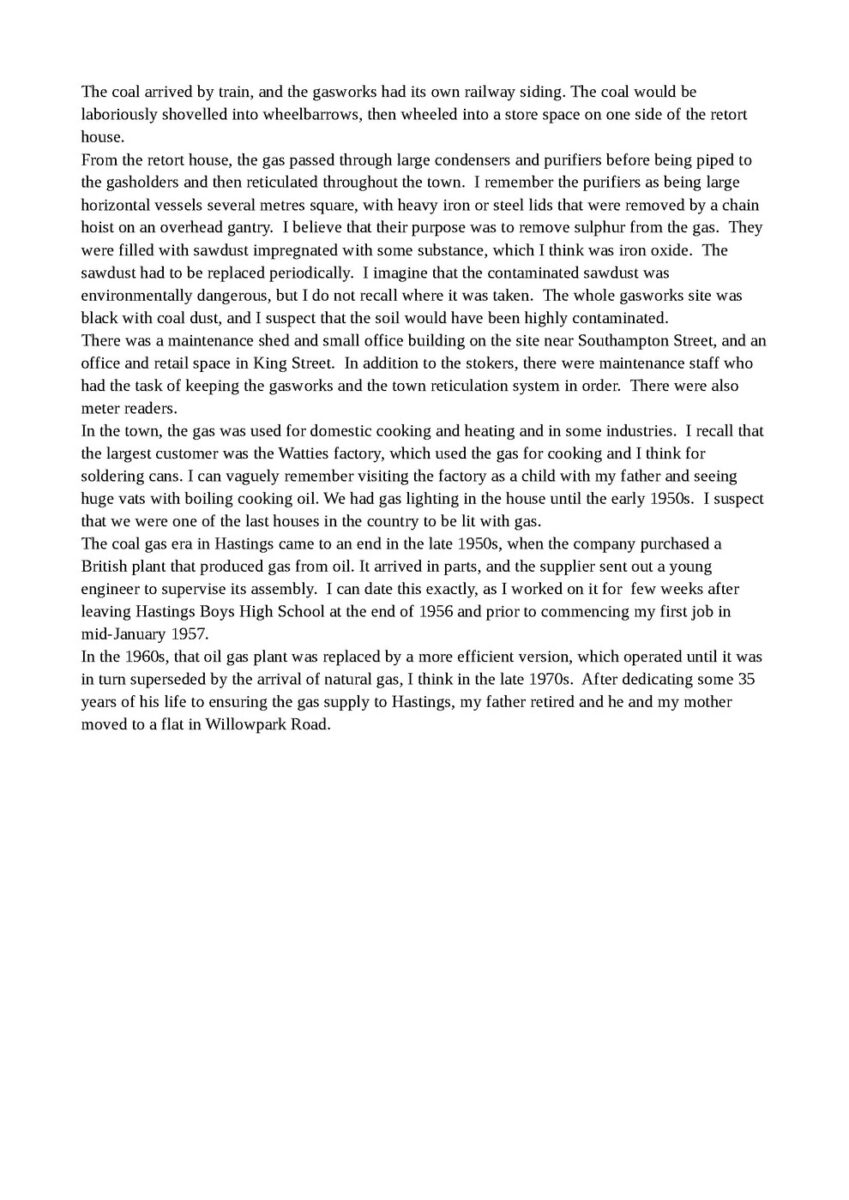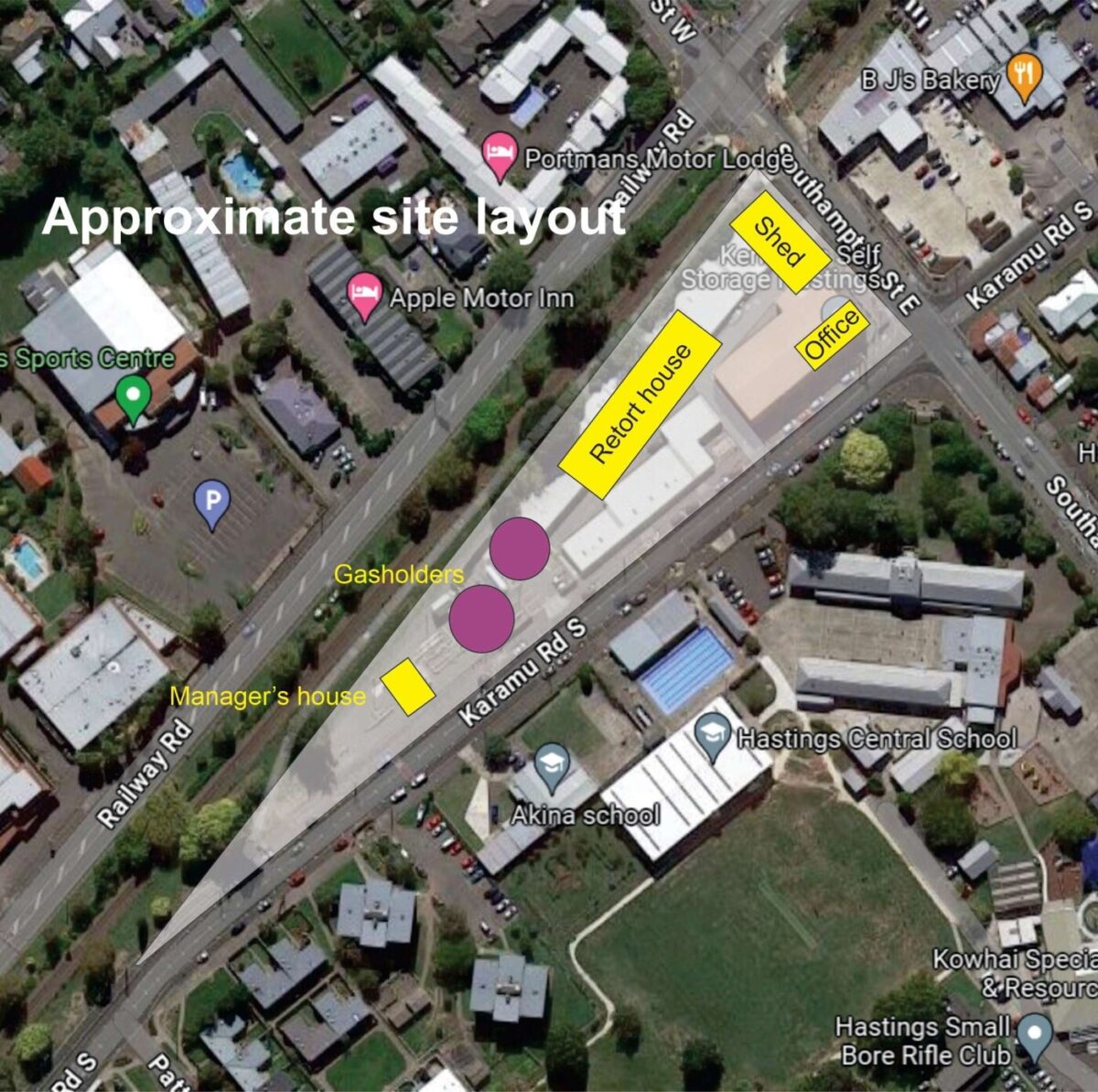RECOLLECTIONS OF THE HASTINGS GASWORKS
by Keith Garratt
In 1942, my father James (Jim) Garratt became Manager of the Hastings gasworks, which was situated on the site in South Karamu Road now largely occupied by Kennards Self Storage. From then until I left home in 1963, I lived with him and my mother in the manager’s house on the gasworks property. The house was in Karamu Road opposite the site now occupied by Akina School, and the site is now occupied by natural gas pipework.
The gasworks was my father’s life until he retired in the late 1970s, and I spent a lot of time with him at the works, particularly as a child in the 1940s and early 1950s, when it was producing gas from coal. I suspect that there are now few people who have firsthand knowledge of the gasworks during that period. The following are my recollections.
I do not know exactly when the Hastings gasworks came into existence. Te Ara states that coal gas “was provided by local authorities and private companies from the 1860s on. By 1916 there were gasworks in 56 cities and towns.” It is safe to assume that the Hastings gasworks dated from that period. It certainly gave every impression of being a product of Victorian times. It was originally a branch of the Napier Gas Company, but in 1954 the Hastings Gas Company was formed and took over the gasworks. I believe that this was in response to a move by the Napier company to close the Hastings operation.
The most obvious feature of the gasworks was the huge gasholder (often wrongly called a gasometer). It was around 20 metres high when full, and maybe 30 metres in diameter. Gasholders were very simple in principle. The bottom section was a huge tank filled with water. The top sections were upturned steel tanks that essentially floated in the water. They rose and fell depending on the amount of gas they contained. The gas was piped in from below. The upper sections had guides to keep them stable. Their weight provided the pressure to reticulate the gas flow to the town through pipes, although the pressure was sometimes boosted by a steam-powered turbine in peak hours. The height that the gasholder rose was a direct indication of the amount of stored gas, and I can clearly remember my father looking out a side window first thing every morning to check how production had been overnight. He took his responsibility to keep the town supplied with gas very seriously.
A second gasholder was built some years after we arrived. This was crafted in the UK and was assembled and welded by specialists who came from there. Also, the original gasholder was deteriorating. A specialist team from the UK welded a whole new skin on it. Interestingly, this was done while it was in use, full of highly inflammable gas.
The heart of the gasworks in Hastings was the retort house, where the gas was produced. This was a large shed with two levels. On the upper level were banks of retorts, which were large D-shaped horizontal ovens perhaps 3 metres deep, like gigantic pizza ovens. They had heavy cast iron doors. These retorts were permanently heated to red heat by coke-fired furnaces on the lower level. In effect, the coal was cooked to drive off the gas, which was drawn off through large vertical pipes. Stokers worked in 8 hour shifts to keep the process going 2 hours a day. Their job was to shovel coal into the retorts, then rake it out into barrows some hours later when the coal had given up its gas. They would douse the hot coal with buckets of water, creating huge clouds of steam. The coal was left as coke, some of which fuelled the furnaces below. The whole scene was like something from the industrial revolution. With the coal dust and extreme heat, working conditions for the stokers were awful, and would certainly not be permissible now.














Do you know something about this record?
Please note we cannot verify the accuracy of any information posted by the community.